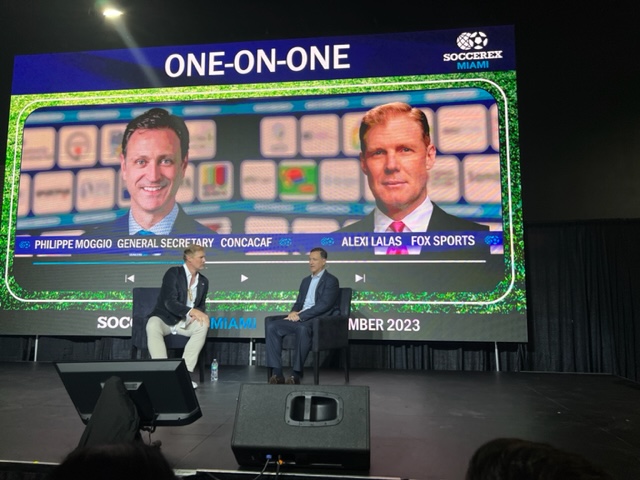By Paul Nicholson in Miami
November 16 – The US is perhaps the hottest place in world football right now in terms of the growth of the game, with major teams and leagues wanting to play there, new teams being announced seemingly every month and a Club World Cup and men’s World Cup on a rapidly nearing horizon.
Phillippe Moggio, general secretary of Concacaf, speaking at the Soccerex Convention in Miami, Florida, said: “The legacy of the 2026 World Cup is not about when it gets here but about what we are doing now to capitalise on it.
“It is highlighting and showcasing competitions that are happening now. We are riding the momentum of these competitions into World Cup 2026 and will continue after.”
That Concacaf has been able to position itself to take advantage of the World Cup is no mean feat considering the parlous state the confederation was in following the US Department of Justice’s assault on FIFA and its federations that brought the international game to its knees.
The rebuild began in 2016 when Victor Montagliani was elected as president of Concacaf and Moggio hired as general secretary. Back then Concacaf was in a tough situation and now famously described by Montagliani “as financially bankrupt, morally bankrupt and football bankrupt”.
“We engineered Governance reform, reworked our statutes and restructured the organisation, bringing in talent from outside,” said Moggio.
“We had a strategy of putting football first and we rebranded with our 41 diamond logo representing our 41 associations and with a focus on unity, football, quality and access.
This has put us in a position to capitalise on the competitions between now and 2026 and build them.”
At the core of this development has been a whole new eco-system of women’s and men’s competitions. Concacaf has increased the value of its men’s Gold Cup, and is launching the women’s version, the W Gold Cup, while at the same time revamping club competitions with regional cups and the Champions Cup (the reversioned Concacaf Champions League).
“Our members benefit because most did not have the opportunity to compete enough. Now they all have the opportunity to play in the four year cycle, whereas before the focus was only on one year in four,” said Moggio
“The Nations League has provided the opportunity to compete at all levels and in every FIFA window. The consistency of competition gives them all the opportunity to compete and prepare teams and qualify for World Cups.”
There is an important point in all of this that goes beyond just the hosting of 2026 and is about football and getting matches played – something Montagliani and Moggio have always put front and centre of their philosophy.
“This is not just about the World Cup 2026 as we would have done this anyway because the reality is we need more football,” said Moggio.
An example of the heightened expectations and thirst for competition is the hosting of Copa America 2024.
“We didn’t have a national team competition or the chance for our nations to play against the best and prepare, heading in to 2026. It is also comparable in the women’s game with the W Gold Cup where we have four Conmebol nations coming to compete,” said Moggio.
The club competition side is similarly important in developing both the mens and womens games and Moggio said “you can expect to see more competition developments in the women’s game soon”.
“I believe everyone will benefit from world Cup 2026. The tide is rising and bringing a tremendous amount of new fans into our world. We have positioned ourselves properly to capitalise on that.”
The saying ‘let the games begin’ in this region feels a little redundant. They have already started.
Contact the writer of this story at moc.l1745668342labto1745668342ofdlr1745668342owedi1745668342sni@n1745668342osloh1745668342cin.l1745668342uap1745668342

